Wilhelm Trutbner Paintings
Wilhelm Trübner was a German painter associated with the Realist and Impressionist movements. Born on February 3, 1851, in Heidelberg, Germany, Trübner was initially trained in the decorative arts and began his formal art education at the Karlsruhe Academy. He was influenced by the works of Gustave Courbet and Edouard Manet and was part of a group of artists referred to as the 'Leibl circle,' which centered around the painter Wilhelm Leibl, who was a proponent of realistic depictions in art.
Trübner's style was characterized by a bold use of color and a focus on the material qualities of paint, often with a preference for still lifes and portraits. His early work featured a somber palette and was heavily influenced by the Old Masters. However, as his career developed, he became increasingly interested in the play of light and color, which led to brighter and more vivid compositions.
In the 1870s, Trübner moved to Munich, which was a hub for avant-garde art at the time. Here, he became acquainted with other important artists of his day, such as Arnold Böcklin and Hans Thoma. Despite his progressive approach to painting, Trübner struggled with financial stability throughout his life, which often affected his ability to produce new work.
Throughout his career, Trübner exhibited his work at various important exhibitions, including the Munich Glaspalast and the Berlin Secession. His contributions to German art were significant, and he played a role in the development of modernism in the country.
Wilhelm Trübner's career was cut short by his untimely death on December 21, 1917, in Karlsruhe, Germany. Despite not achieving widespread fame during his lifetime, his work has been reassessed and appreciated in more recent times for its innovative qualities and its role in the transition from academic painting to modern art. Trübner's paintings can now be found in various museum collections, and he is recognized as an important figure in the German art scene of the late 19th and early 20th centuries.
